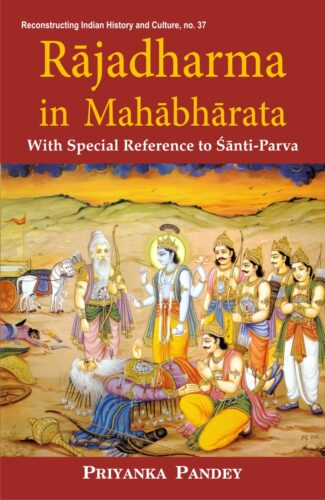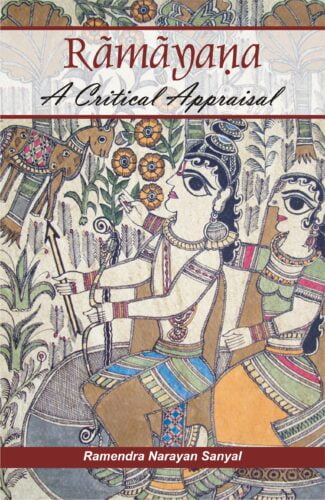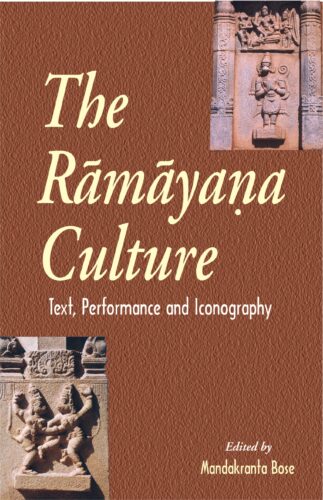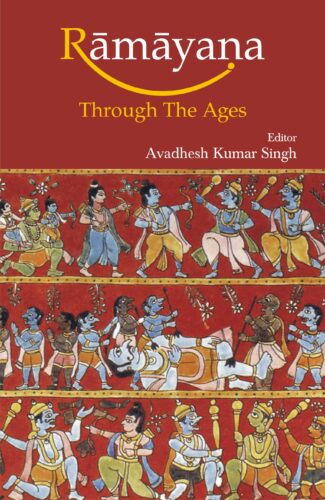Showing 771–780 of 1125 results

This book is a systematic and contemporary exploration of the uniquely Indian phenomenon of raga, which forms the foundation of the musical culture of India. It attempts to extend the scope of the enquiry to cover several facets of ragas examining the manner in which they participate in the cultural process.
This book is a systematic and contemporary exploration of the uniquely Indian phenomenon of raga, which forms the foundation of the musical culture of India.
Maestros speak with total conviction of a raga as having a personality. A raga must therefore be viewed not only as the governing authority of musical performance, but also as an archetype pregnant with cultural meaning. The exploration of raga-ness, therefore, can begin with the grammatical coordinates of ragas, but cannot stop there. This book attempts to extend the scope of the enquiry to cover several other facets of ragas examining the manner in which they participate in the cultural process. As such, this book provides valuable insights to scholars, researchers, connoisseurs, as well as performing musicians.
Written by an author of established credentials as a musician, researcher and writer with three acclaimed works to his credit, this book explores the subject through conceptual essays in Part I, and case studies of fifty-one ragas in Part II. The case studies of ragas are supported with references to authoritative texts and reviews of recordings by recent and contemporary maestros.
Written in the author’s lucid and masterly style, this book makes complex musicological concepts accessible to non-academic readers, and contributes significantly to widening the understanding of the role of ragas in the musical culture.

This composition of the sixteenth century, edited and commentated upon by Acharya Bhagawat Sharan Sukhla, introduces eighty-seven ragas, some are famous such as Bhairav, Bhairavi, Vasant, Tohri and Malkauns, and some are little known like Rodika, Saurashtri, Aothi, Yogi Bangalika and Kurai. It is part of the ongoing efforts of the National Mission for Manuscripts, giving exposure to the unpublished Sanskrit volumes.
The experiences and knowledge from our past are recorded in manuscripts which have been handed down to us over several thousand years. The Government of India, through the Department of Culture, took note of the importance of the vast tangible heritage and in order to preserve and conserve as well as to make access to this wealth easy, established the National Mission for Manuscripts. In order to disseminate the knowledge content of manuscripts, the Mission has taken up several programmes such as lectures, seminars and workshops. The Mission has published the proceedings of the above-said programmes under the following series: Samrakshika (on conservation), Kritibodha (critically edited texts), Tattvabodha (comprises lectures based on some manuscripts delivered by eminent scholars) and Samiksika (research-oriented papers as presented in the seminars). This year, the National Mission for Manuscripts has taken up a project for publishing rare and unpublished manuscripts in three formats (a) Facsimile, (b) Critical edition (illustrated and single copy manuscript), (c) Critical edition with annotation and translation. This new series has been named as Prakashika. Ragarnavam, critically edited by Acharya Bhagawat Sharan Shukla, comes under this series.
The happiness from the knowledge of music is well-known. From the very beginning of creation, music was the part and parcel of human civilization. Its relevance to our lives is known from the Vedic period. Besides nataka, Rishi Bharata is considered as the acarya of music too. To enrich this knowledge, many saint-composers devoted themselves to shastraic compositions. Ragarnavam is one of such compositions. Though no details are available on the compositor, this work is a sufficient proof of the composer’s mastery.
Ragarnavam, it is believed, was composed somewhere in the sixteenth century. It is a collection of eighty lyrics. Acharya Bhagawat Sharan Shukla has edited and written commentary on it, in the backdrop of the two available manuscripts of this composition. This composition introduces nearly eighty-seven ragas some are famous, some are little known. While this composition details famous ragas like Bhairav, Bhairavi, Vasant, Torhi, and Malkosh, it features ragas like Rodika, Saurashtri, Aothi, Yogi Bangalika, Kurai, as well.
This book will definitely be a boon to the music lovers. It can even entice researchers on music. This volume is part of the ongoing efforts of the National Mission for Manuscripts, giving exposure to the unpublished Sanskrit volumes.

Goutam Ghosal tells lucidly the magic pairing story of two of the ever renowned poets of India Tagore and Sri Aurobindo. Both these poets are in love with the oppressed earth wishing it to change one day into a beautiful planet. They are not satisfied with God, sitting high above in the blue, and wish to bring Him down on this polluted and plundered globe.
The link between Tagore and Sri Aurobindo has been too insufficiently explored. There is no book as yet in English, which has attempted to integrate the two makers of the modern Indian tradition. One searches in vain for a critical comparative study of the two writers in any other Indian language. The book traces back the formative influences of the two mighty Bengalees growing up almost together without any interaction between them till the first decade of twentieth century. While Tagore took a direct initiative in meeting the yogi in Pondicherry, Sri Aurobindo wrote about his contribution silently listing him as one of the pioneers of the future poetry along with Whitman, Carpenter and others. Basically, both poets are in love with this oppressed earth, wishing it to change one day into a beautiful planet. The Divine is certainly an engaging passion for both of them. But they are not quite satisfied with God who stays far away from us hidden in the high far blue. They wish to catch Him in the net of their poetry and love and bring Him down here on this polluted and plundered globe. Dreamers of a new creation on earth, they wish to form a rainbow bridge marrying the soil to the sky. Goutam Ghosal tells the story of that magic pairing lucidly, keeping the balance throughout. He seeks for an integral view of the two masters, which comes out through his observations on their poetry and fiction, drama and criticism, letters and casual notes. A new approach to Tagore’s music and painting is an added charm of the book.

This book deals with all aspects of politics based on Mahabharata and addresses topics such as dandaniti, origin of state, the seven elements of state, functions of state, types of state, kinship, judiciary and administration in detail, among many other issues of political importance.
The idea of politics hardly finds an expression elsewhere as clearly as in Mahabharata. This work thus investigates the political thought explicit in Shanti-Parva and emphasizes that Mahabharata is a text in the study of politics, apart from the perception of it being a great epic and a text of high literary value. Whatever be the notion of politics we contemplate upon, it finds an articulation in Mahabharata. As the Greek tradition of thinking is the base of Western politics, Shanti-Parva of Mahabharata represents the Indian notion of political thinking, though there remain many similarities and dissimilarities between the two systems.
This volume navigates one to how to read Mahabharata as a political text; the idea of political thoughts, the constituting principles of politics and the political institutions in Shanti-Parva; and the relevance of these political thoughts in modern time. Topics such as dandaniti, origin of state, the seven elements of state, functions of state, types of state, kinship, judiciary and administration are discussed in detail, among many other issues of political importance.
The book collects, analyses and examines the internal evidences from Shanti-Parva and also from other parvans of Mahabharata to reach a decisive conclusion, making the work a composite result of textual analysis, related literature and subjective contemplation. It clearly shows that the idea of politics is not separated from the idea of ethics. Rather they are intertwined.

Written in a simple and lucid language, this book discusses the major events of the Ramayana, analysing and interpreting them from different angles. This volume should fascinate readers who want to gain a fresh perspective on the glorious Ramayana tradition.
Based on the Valmiki Ramayana, this book discusses the major events of the Ramayana including those in the Uttara-Kanda, analyzing and interpreting them with a fresh approach. Written in a simple and lucid style, the work deals with the birth of Rama, his destruction of rakshasas accompanied by his brother Lakshmana, of Dasaratha, Ramas exile, the many developments that led to the war between Rama and Ravana and the later events like Ramas coronation, his abandonment of Sita and the last journey of Lord Rama. It brings out the many qualities of Rama like virtuousness, courage, compassion, equanimity of mind, devotion to duty and truth, and selflessness that make Rama a glorious, divine figure and the story in the Ramayana an unparalleled epic of the world. It also discusses the controversial acts of Rama like his killing of Vali and humiliation of Sita after her rescue. It underlines the importance of the example of Rama and the teachings of the Ramayana in the contemporary world.
The volume will fascinate a range of readers general readers as well as scholars of Indian religion and culture who want to gain a fresh perspective on the glorious Ramayana tradition.

The essays in this volume approach the Ramayana from different perspectives textual criticism, art and architecture, and film to understand its ideological and aesthetic meanings. They address critical issues like the seminal status of Valmiki, gender representation in Ramayana and the importance of the so-called Ramayana derivatives.
These essays, originally presented at an international conference, are in the forefront of the modern response to an ancient work that has gained a new critical and social relevance in contemporary scholarship. Approaching the Ramayana from several angles in an attempt to understand its aesthetic and ideological meaning, they examine the epic through the perspectives of textual criticism, art, architecture and film. Thereby they address critical issues such as the seminal status of Valmiki, the underlying problem of canonicity itself, the importance of other — so-called derivative — Ramayanas, the implications of gender representation, and the cultural manipulation of social ideals relating to the position of women and the idealisation of love that achieves its highest value in marriage. Using the methods of rigorous textual and historical investigation, each essay seeks not only to uncover the layers of meaning in the complex structure of the epic in its varied forms but also to situate it critically in the cultures of South and Southeast Asia.
The book commences with a short wrap-up of the history of Cambodia with the arrival of Sage Kaundinya and comes down to the coronation ceremonies of Cambodian monarchs to whom the brahmin Grand Master hands the statues of Lords Siva and Visnu as the keeper of Divine Values (dharmaraja), and the Sacred Sword with the mantra ‘Take, for Thou art the Lightning of Indra’. The Grand Master is called Rama-rajya-adhipati. Prof. RaghuVira wanted to publish all the 442 Sanskrit inscriptions of Cambodia in Devanagari and their facsimiles. Prof. Coeaes sent their list which has been reproduced here. It shows how Sanskrit was the language of the state till the 12th century. After long-drawn negotiations the Government of Cambodia sent monk Ven. Candravarna in 1961. He obtained the Ramakirti from his uncle (parts 1-6, 8-10, 75). He used to transcribe the Cambodian text into Devanagari and give a resume which wrote down in English. Both have been reproduced here

The tradition of Rama-Katha existed in many folk and oral forms before Adikavi Valmiki wrote the Sanskrit Ramayana. The subsequent centuries witnessed composition of Ramayana in Tamil, Malayalam, Bengali, Assamese, Hindi, Kashmiri, Gujarati, Marathi, etc. This volume shares their many similarities and dissimilarites.
The long and continuous tradition of Rama-Katha existed in many folk and oral forms before Adikavi Valmiki composed it in Sanskrit in written form as the Ramayana, a book of divine harmony . . . a bottomless and shoreless ocean of love, piety and clemency. The subsequent centuries witnessed composition of Ramayana in many Indian languages like Tamil, Malayalam, Bengali, Assamese, Hindi, Kashmiri, Gujarati and Marathi among others. These versions share many similarities and some dissimilarities among them, though their epicentral concerns remain the same.
The present volume comprising more than a dozen articles by distinguished scholars discuss Ramayana in different Indian languages. The volume, it is hoped, would lead to mutual illumination of Rama-Katha in different Indian languages and facilitate greater understanding of its timeless appeal and journey through ages.

Dr. Patnaik elucidates the fundamentals of the rasa theory and applies the canons of this theory to various modern Western literary works, Chinese love lyrics and the Japanese haiku poems. Its historical development and recognition are discussed.
The Indian tradition of criticism is over two millennia old. And its rasa theory has, from the beginning, essentially influenced authors, connoisseurs and art critics alike. First expounded sometime between the 1st century bc and the fourth century AD in the eminent aesthetician, Bharata’s Natya Shastra, rasa theory deals with the ‘emotive content’ of a work of art — how it is depicted, inferred and transmitted. Dr. Patnaik’s book is a unique effort that demonstrates, with diverse examples, the universality of this ancient theory and its applicability to modern Western classics. Elucidating afresh the concept of rasa and all its nine primary kinds largely on the basis of Natya Shastra of Bharata and the commentaries of the tenth-century aesthetician, Abhinavagupta, the book investigates the validity of rasa theory as an aesthetic, more specifically, a literary theory, and how its canons are applicable to modern Western literature as well as Chinese love lyrics and Japanese haiku poems. Dr. Patnaik’s transcultural exploration, thus, covers all major genres of literature — poetry, drama and fiction; and also major writers — Lawrence, Mayakovsky, Kafka, Camus, Conrad, Hemingway, Faulkner, Marquez, Eliot, Hesse, O’Neill, Ionesco, Beckett, Lorca, Neruda and several others. In emphasizing the universal validity of the rasa theory, the author considers certain modern problems relevant to text, meaning and readers’/audiences’ response as well. Very few are the examples of applied rasa theory even in Sanskrit and other Indian literatures, leave alone its application to Western creative writing. This book, with its bold framework and lucid style, should, therefore, fascinate the scholars of Indology, Indian aesthetics and, above all, comparative literary criticism.

?????: ??????????????? ?? ?? ??????, ???? ??? ????? ?? ????? ?? ???? ??, ???? ??? ?? ?????? ????? ?? ???? ?? ???? ???? ?? ????? ???? ?? ?? ????? ???????? ?? ?????-???? ??, ??????? ????? ??????? ?????? ?? ???? ???? ???? ??, ??????? ?????? ??????? ??? ??? ?? – ?????? ??????? ?? ????? ?????? ???? ?????-??????? ??? ??? ???? ??????? ?? ????????? ?? ?? ?? ??? ??? ????? ???? ????? ?? ????? ??? ?? – ???????-????????
??????????????? ?? ?? ??????, ???? ??? ????? ?? ????? ?? ???? ??, ???? ??? ?? ?????? ????? ?? ???? ?? ???? ???? ?? ????? ??????? ???????? ?? ??? ??, ??? ???????? ?? ???? ?? ?????????? ???? ???? ???? ???????? ?? ???????, ???????, ?????????? ?? ????????????? ?? ????? ???? ?? ?? ????? ???????? ?? ?????-???? ??, ??????? ????? ??????? ?????? ?? ???? ???? ???? ??, ??????? ?????? ??????? ??? ??? ?? µ ?????? ??????? ???????? ?? ??????? ??? ????? ???? ??? ?????? ???????? ???? ??? ??? ?????? ???? ???? ??? ???? ???? ???? ??? ?? ????? ?????? ???? ?????-??????? ??? ??? ???? ??????? ?? ????????? ?? ?? ?? ??? ??? ????? ???? ??????? ?? ???????? ?? ?????? ?? ???? ??????? ?? ??? ??? ?????? ???? ??????? ??? ????? ?? ????????? ?? ???? ??? ??? µ ??? ?? ??? ??? ???, ??? ?? ?????? ??? ? ??? ?????
| There are no products |